
The Maricel Museum is a museum located in the centre of Sitges; [1] reopened after a major refurbishment in 2015. [2]
Contents
The Maricel Museum is part of the Barcelona Provincial Council Local Museum Network.

The Maricel Museum is a museum located in the centre of Sitges; [1] reopened after a major refurbishment in 2015. [2]
The Maricel Museum is part of the Barcelona Provincial Council Local Museum Network.
In 1969, the Barcelona Provincial Corporation bought the building of Maricel de Mar to house the heterogeneous collection belonging to Doctor Jesús Pérez-Rosales (Manila, 1896-Barcelona, 1989), a well known gynaecologist and enthusiastic collector. A year later the Museu Maricel was inaugurated.
Made up of more than 3 000 items of varying origin, the collection includes Romanesque murals (like the Christ Pantocrator from Santa Maria de Cap d'Aran, dated in the twelfth century), examples of Gothic painting on wood (amongst them two pieces from the altarpiece of Sant Pere de Cubells), Renaissance carvings and altarpieces, Modernista and Noucentista sculptures by Josep Llimona (Distress), Enric Clarasó head of Child Crying, Joan Rebull (Rest, Dawn and Gypsy Child), Josep Clarà, Josep Cañas and Pablo Gargallo (The Reaper), six allegorical murals by Josep M. Sert on the First World War, along with numerous pictures and items of furniture, precious metal, ceramics and porcelain.

Since 1995 the Museu Maricel has also housed the "Vila de Sitges" Collection of art, which occupies several rooms on the second floor. In them can be seen some fifty works by Sitges artists of the nineteenth and twentieth centuries and by others who had close links with the town during the same period.
This art collection takes the visitor on an evocative tour of the last two centuries of Catalan painting, from Joaquim Espalter (born in Sitges in 1809) to Pere Pruna (who spent long periods here during the 1940s and 1950s).

The Luminist School of Sitges, which provided a bridge between Marià Fortuny and the Modernistes, is amply represented, with items by Felip Masó (amongst them the emblematic Saint Bartholomew Procession), Joaquim de Miró (The Malvasia Harvest), Josep Batlle i Amell, Arcadi Mas i Fondevila (The Corpus Christi Procession in Sitges), Joan Roig i Soler and Antoni Almirall.
There are also several works by Santiago Rusiñol, in particular Twilight, painted in Biniaraix (Majorca), and the portraits of local figures in Sitges such as Salvador Robert, Pere Forment and Lluís Magrans. There is an exceptional portrait by Ramon Casas of Charles Deering, the man who had the Maricel complex built at the beginning of the twentieth century.
Maternity, by the Sitges painter Joaquim Sunyer, opens the room devoted to Noucentisme, where one can also see canvases and drawings by Agustí Ferrer Pino, Josep Vidal and Josep M. Llopis de Casades, amongst others. The exhibition is completed with items by Artur Carbonell (Girl in Mourning), Guillem Bergnes (Rocks of Sant Sebastià), Alfred Sisquella and Pere Pruna (mentioned above).
Adjoining the "Vila de Sitges" Collection of Art is the Collection on Maritime themes put together by Emerencià Roig i Raventós (Sitges, 1881-Barcelona), 19359[ clarification needed ] and donated by his brother to Sitges Town Hall. Roig was an important specialist in maritime themes and the author of books like La pesca a Catalunya (1926), La marina catalana del vuit-cents (1929) and Sitges del nostres avis (1934).
The collection consist of a variety of models and miniature boats, drawings and engravings, maps, nautical instruments (sextants, compasses, etc.) and fishing tackle (lobster pots, long lines, hooks, needles for mending nets, etc.), which were once used by fishermen the length of the Catalan coast.

Terrassa is a city in central-eastern Catalonia (Spain). It is one of the two capitals of Vallès Occidental county, along with Sabadell.
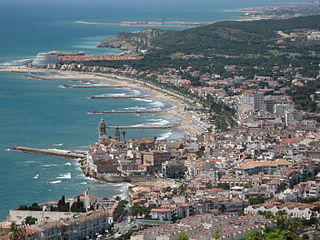
Sitges is a town about 35 kilometres southwest of Barcelona, in Catalonia, Spain, renowned worldwide for its film festival, Carnival, and LGBT culture. Located between the Garraf Massif and the Mediterranean Sea, it is known for its beaches, nightspots, and historical sites.

Ciutat Vella is a district of Barcelona, numbered District 1. The name means "old city" in Catalan and refers to the oldest neighborhoods in the city of Barcelona, Catalonia, Spain. Ciutat Vella is nestled between the Mediterranean Sea and the neighborhood called l'Eixample.

Sant Pere de Ribes is a town in the center of the Garraf comarca, in Barcelona province, Catalonia, Spain. The remains of a 12th-century castle once ruled by the troubadour Guillem de Ribes are in the town.

The Palau de la Generalitat de Catalunya is a historic palace in Barcelona, Catalonia, Spain. It houses the offices of the Presidency of the Generalitat de Catalunya. It is one of the few buildings of medieval origin in Europe that still functions as a seat of government and houses the institution that originally built it.

Vilanova i la Geltrú is the capital city of Garraf comarca, in the province of Barcelona, Catalonia, Spain. Historically, it is the result of the aggregation of the medieval center of La Geltrú with the center built outside the medieval walls, Vilanova. Initially, the lands of Vilanova belonged to Cubelles, the neighboring town. The city of Vilanova i la Geltrú has a growing population of approximately 66,000, and is situated 40 km south-west of Barcelona, with the coastal resort of Sitges some 10 km to the north-east.

The Museu Nacional d'Art de Catalunya, abbreviated as MNAC, is a museum of Catalan visual art located in Barcelona, Catalonia, Spain. Situated on Montjuïc hill at the end of Avinguda de la Reina Maria Cristina, near Pl Espanya, the museum is especially notable for its outstanding collection of romanesque church paintings, and for Catalan art and design from the late 19th and early 20th centuries, including modernisme and noucentisme. The museum is housed in the Palau Nacional, a huge, Italian-style building dating to 1929. The Palau Nacional, which has housed the Museu d'Art de Catalunya since 1934, was declared a national museum in 1990 under the Museums Law passed by the Catalan Government. That same year, a thorough renovation process was launched to refurbish the site, based on plans drawn up by the architects Gae Aulenti and Enric Steegmann, who were later joined in the undertaking by Josep Benedito. The Oval Hall was reopened for the 1992 Summer Olympic Games, and the various collections were installed and opened over the period from 1995 to 2004. The museum was officially inaugurated on 16 December 2004. It is one of the largest museums in Spain.
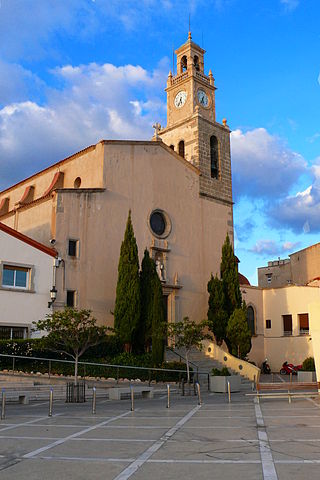
El Masnou is a municipality in the province of Barcelona, Catalonia, Spain. It is situated on the coast between Montgat and Premià de Mar, to the north-east of the city of Barcelona, in the comarca (county) of el Maresme. The town is both a tourist centre and a dormitory town in the Barcelona Metropolitan Area.

La Guingueta d'Àneu is a municipality in the comarca of the Pallars Sobirà in Catalonia, Spain. It is situated in the valley of the Noguera Pallaresa river below the reservoir of La Torrassa. It is linked to Sort by the C-147 road.

The Maristes Valldemia school, is located in Mataró, Province of Barcelona - Catalonia (Spain). It is a catholic school run by Marist Brothers, and dedicated to Our Lady the Virgin of the Candle. The ownership is held by Fundació Champagnat, Fundació Privada.
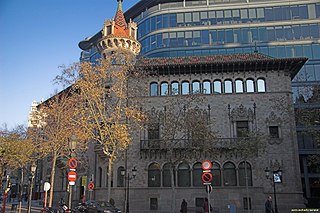
The Barcelona Provincial Council Local Museum Network, also known as Catalonia’s Biggest Museum, is a tool for support and collaboration from and for the museums of the province, which makes available to municipalities a series of services and actions aimed at improving, through the provision of direct services and research into viable formulas for supramunicipal cooperation, the management, conservation and dissemination of heritage and the museum facilities of the towns of Barcelona province. It is managed from the Cultural Heritage Office, which in turn depends on the Department of Knowledge and New Technologies of Barcelona Provincial Council.
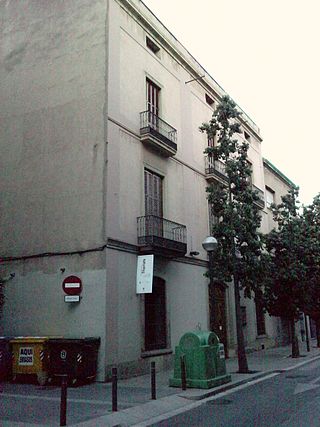
The Sabadell Art Museum or MAS is a museum specialised in Catalan painting from the 19th and 20th centuries and is located in Sabadell, the capital of El Vallès Occidental. It is part of the Barcelona Provincial Council Local Museum Network.
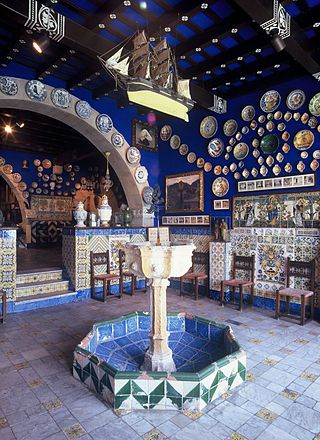
Cau Ferrat, located in Sitges, was the home and study of artist and writer Santiago Rusiñol, one of the most important figures of the Modernisme movement in Catalonia. It is one of the three museums in Sitges located on the shores of Sant Sebastià beach.

The Can Llopis Romanticism Museum is a museum located in Neoclassical-style building in the centre of Sitges and is part of the Barcelona Provincial Council Local Museum Network.

Joaquin Mir Trinxet or Joaquin Mir y Trinxet was a Catalan artist known for his use of color in his paintings. He lived through a turbulent time in the history of his native Barcelona. His paintings helped to define the Catalan art movement known as modernisme.

Arcadi Mas i Fondevila, or Fontdevila, was a Catalan painter and graphic artist.

Joan Triadu i Font was a Catalan literary critic, academic and writer. A cultural and resistant anti-Francoist activist, he was involved in many important Catalan cultural projects in the twentieth century, including the magazines Serra d'Or and Ariel, the newspaper Avui and the association Òmnium Cultural. He was a pioneer in the teaching of Catalan language courses after the Spanish Civil War. As an educationalist, he was the general director of the Cultural Institute of the Centre of Catholic Influence, an institution that created the Thau Barcelona School in 1963 and the Thau Sant Cugat School in 1996. Joan Triadú Year, which marked the centenary of his birth, was celebrated in 2021.
Pau Rigalt i Fargas was a Catalan painter and scenographer. He was one of the pioneers of Neoclassicism in Catalonia.